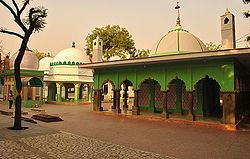Other names Chiragh Dehlavi Successor Bande Nawaz | Name Nasiruddin Dehlavi Role Poet Based in Delhi | |
 | ||
Title چراغِ دہلی Chiragh-e-Dehli | ||
Period in office Early 14th century | ||
47 story of hazrat nasiruddin chiragh dehlavi india
Nasiruddin Mahmud Chirag-Dehlavi (ca 1274-1356) was a 14th-century mystic-poet and a Sufi saint of the Chishti Order. He was a murid (disciple) of noted Sufi saint, Hazrat Nizamuddin Auliya, and later his successor. He was the last important Sufi of the Chishti Order from Delhi.
Contents
- 47 story of hazrat nasiruddin chiragh dehlavi india
- Nasiruddin Chiragh dehlavi Chishti Chiragh e delhi dargah Ziyarat Qawwali Mere pir ki gulami
- Biography
- Disciples
- Dargah
- Legacy
- Khanzada Jadubansi Rajputs their acceptance of Islam
- Acceptance of Islam
- References

Dehlavi was given the title, "Roshan Chirag-e-Delhi", which in Urdu, means "Illuminated Lamp of Delhi".

Nasiruddin Chiragh dehlavi Chishti - Chiragh-e-delhi dargah, Ziyarat& Qawwali - Mere pir ki gulami
Biography
Nasiruddin Mahmud Chiragh Dehlavi (or Chiragh-e-Delhi) was born as Syed Nasiruddin Mahmud AlHassani around 1274, at Ayodhya, Uttar Pradesh. Dehlavi's father, Syed Mahmud Yahya AlHassani, who traded in Pashmina, and his grandfather, Syed Yahya Abdul Latif AlHassani, first migrated from Khorasan, northeastern Iran, to Lahore, and thereafter settled in Ayodhya, in Awadh. His father died when he was only nine years of age and he received his early education from Maulana Abdul Karim Sherwani, and later continued it with Maulana Iftikhar Uddin Gilani.
At age forty, he left Ayodhya for Delhi, where he became the disciple of Khwaja Nizamuddin Auliya. It was here that Dehlavi stayed for the rest of his life as his murid (disciple), and after his death, became his successor. In time, he also became a known poet in Persian language.
He died in 17 Ramzan 757 Hijri or 1356 AD, at the age of 82, and is buried in a part of South Delhi, India which is known as "Chirag Delhi" after him.
Disciples
One of his noted disciples was Bande Nawaz Gezu Daraz, who later moved to Daulatabad around 1400, owing to the attack of Timur on Delhi, and from where at the invitation of Bahamani King, Firuz Shah Bahamani, moved to Gulbarga, Karnataka, where he stayed for the following 22 years of his life, spreading the Chishti Order in the South, until his death in November 1422. The dargah (mausoleum) of Khwaja Bande Nawaz, exists today in the city of Gulbarga, as a symbol of multi-religious unity.
During his stay in Delhi, Dehlavi continued to visit Ayodhya often, where he made a number of disciples, notably, Shaikh Zainuddin Ali Awadhi, Shaikh Fatehullah Awadhi and Allama Kamaluddin Awadhi. Hazrat Kamaluddin Allama was his nephew and made him his successor and thereafter his successors are in Ahmedabad Gujarat India present successor of Khanqa E Auliya Chishtiya is Khawaja Ruknuddin Mohammed Farrukh Chishti. He resides at Nasirbaug, Shahibaug, Gujarat , Ahmedabad, India
Dargah
After his death, his tomb was built by Firuz Shah Tughluq (r. 1351 - 1388), the Sultan of Delhi in 1358, and later two gateways were added on either side of mausoleum. One of noted addition was a mosque built by a later Mughal emperor, Farrukhsiyar, in the early 18th century, and popular among both Muslims and non-Muslims. A humble tomb of the founder of Lodhi dynasty, Bahlul Khan Lodhi (r.1451-89) lies close to the shrine, in the present day locality of ‘Chirag Delhi’ that grew around the tomb since 1800, and still goes by his name, it is very close to the locality of Greater Kailash, in South Delhi. location of dargah from google map Chirag Delhi Dargah
7JWVG6QG+FR https://goo.gl/maps/VMrQzTUqwDU2
Legacy
Nasiruddin Chiragh Dehalvi, unlike his spiritual master Nizamuddin Auliya, did not listen to sema, which was considered un-Islamic by a section of the Muslim intelligentsia in that period. He did not however pass any specific judgement against it. This is the reason why even today, qawwali is not performed near his shrine in Delhi. Hazrat Nasiruddin's descendants are to be found far and wide as a lot of them moved down South to Hyderabad. The dargah of Badi Bua or Badi Bibi, who said be the elder sister of Nasiruddin Mahmud Chiragh Dehlavi, still exists in city of Ayodhya.
Khanzada Jadubansi Rajputs, their acceptance of Islam
Khanzadah, the Persian form of the Rajputana word Rajput, is the title of the representatives of the ancient Jadubansi royal Rajput family, descendants of Krishna and therefore of Lunar Dynasty.
Jadon (also spelled Jadaun) Rajput Raja Lakhan Pala, the progenitor of the family of the Khanzadahs, was the grandson of Raja Adhan Pala (who was 4th in descent from Raja Tahan Pala). Tahan Pala, who founded Tahangarh, was the eldest son of Raja Bijai Pala (founder of Bijai Garh), who himself was 88th in descent from Lord Krishna. Hence, Jadon Raja Lakhan Pala, Mewatpatti (title means, Lord of Mewat) was 94th in descent from Lord Krishna.
Acceptance of Islam
The family records of Khanzadahs states that during one of the hunting expedition Kunwar Samar Pal and Kunwar Sopar Pal, the sons of Jadon Raja Lakhan Pal, met with Sufi saint Nasiruddin Mahmud, Roshan Chiragh-i Dehli. The acceptance of Islam by Khanzadahs have been a 'enlightenment of heart' come about from their association with the Sufi saints.
